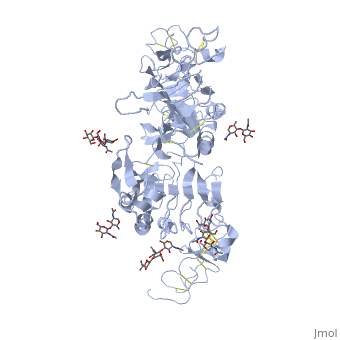MAPK/ERK pathway (also known as the Ras-Raf-MEK-ERK pathway) is a chain of proteins in the cell that communicates a signal from a receptor on the surface of the cell to the DNA in the nucleus of the cell.
Cell surface receptors that can activate this pathway via GRB2
Epidermal Growth Factor Receptor (EGFR; see also Epidermal growth factor). EGFR belongs to Receptor tyrosine kinases, class I.
Trk A/B: High affinity nerve growth factor receptor (TrkA). TrkB tyrosine kinase receptor. See also Neurotrophin.
Fibroblast growth factor receptor
Platelet-derived growth factors and receptors
Growth factor receptor-bound proteins (GRB) are adaptor proteins. GRBs contain SH2, Ras-associated (RA) and pleckstrin homology (PH) domains. For additional details on GRB10 see Grb10 SH2 Domain.
Ras activation
GTPase KRas
Allosteric modulation of H-Ras GTPase.
Kinase cascade
RAF kinase
B-Raf is related to retroviral oncogenes and participates in cellular signal transduction. B-Raf domains include the kinase domain - residues 444-721 and Ras-binding domain - residues 153-237. Mutated B-Raf was found in some human cancers[1]. See more in B-RAF with PLX4032.
c-Raf is part of the MAPK pathway. c-Raf domains include the kinase domain - residues 323-618, cysteine-rich domain – residues 136-187 and Ras-binding domain - residues 51-132. Mutations of c-Raf are possible causes of Noonan syndrome[2]. For details on c-Raf see Molecular Playground/C-Raf.
Mitogen-activated protein kinase kinase kinase
MAPKs
Targets for phosphorylation by MAPKs
One of the first proteins known to be phosphorylated by ERK was a microtubule-associated protein (MAP)
Regulation of translation and transcription
One effect of MAPK activation is to alter the translation of mRNA to proteins.
MAPK can phosphorylate C-myc
MAPK phosphorylates and activates MNK, which, in turn, phosphorylates CREB. The activated CREB protein then binds to a CRE region, and is then bound to by CBP (CREB-binding protein), which coactivates it, allowing it to switch certain genes on or off. CBP is a transcription activator.
Genes whose transcription is regulated by CREB include: c-fos, BDNF, tyrosine hydroxylase, numerous neuropeptides (such as somatostatin, enkephalin, VGF, corticotropin-releasing hormone), and genes involved in the mammalian circadian clock (PER1, PER2).
Clinical significance
Raf kinase inhibitors
- The first drug licensed to act on this pathway is sorafenib — a Raf kinase inhibitor.
- Dabrafenib e.g. 4xv2 - B-Raf Kinase V600E oncogenic mutant in complex with Dabrafenib.
- B-Raf Kinase Inhibitor Zelboraf - Generic: Vemurafenib (Formerly: PLX-4032), see B-RAF with PLX4032.
MEK inhibitor
- Cobimetinib or XL518, approved by US FDA in Nov 2015 for use in combination with vemurafenib (Zelboraf(R)), for treatment of advanced melanoma with a BRAF V600E or V600K mutation (see above). 4lmn - MEK1 kinase bound to MEK1 kinase bound to Cobimetinib (GDC0973).

